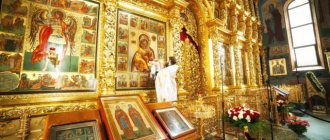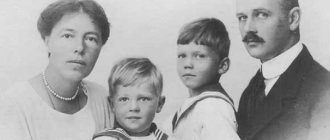Holy Princess Olga is a legendary figure in the history of our country and equally controversial for many. Canonized by the Orthodox Church as Equal to the Apostles, she is known not only for her harsh vindictiveness and political ambition. But also with conscious and deep faith.
The description of Olga's trip to Constantinople, where she was baptized, is not only, but, as many historians believe, not so much historical as literary material, behind which lies the real story of the beginning of the long path to the Christianization of Rus', which ultimately resulted in the baptism of Prince Vladimir .
Western Christianity
However, few people know that Rus' under Olga had every chance of becoming a state where Christianity of the Western rite would be professed. This happened even before the split into the Orthodox and Catholic churches, although disagreements between the Christian East and West were already clearly visible. And, interestingly, most likely, it was the pagans who did not allow such a “Western” Christianization of Rus'.
But in order to understand the essence of this story, which is silent about in Russian chronicles, but is repeatedly mentioned in Western sources, you need to start with Olga’s trip to the capital of the Byzantine Empire to receive the basileus.
Trip to Constantinople
If we recall the plot of “The Tale of Bygone Years,” then around 955-957 Olga, being regent under Prince Svyatoslav, made an embassy to Constantinople to the court of the emperor. According to the Tale, the emperor wanted her as his wife. At first, Olga referred to her paganism, and after she was baptized by Patriarch Theophylact of Constantinople, and Basileus Constantine Porphyrogenitus himself became his successor, she explained to the latter that now he is her godfather, and they definitely won’t be able to get married. With this I went back to Kyiv.
However, in this story everything was somewhat more complicated. The historian Kartashov points out that the very next year the Byzantine embassy was expelled from Kyiv. He also mentions that in the official Byzantine chronicle “On Ceremonies” the description of Olga’s visit is given, although in detail, but very dryly, in official language, while the purposes of this visit are not reported.
However, an Orthodox priest is separately mentioned in the princess’s retinue. From all this data, Kartashov concludes that Olga really seriously decided to accept the Christian faith or had already been baptized earlier, but at the same time her embassy was also “matchmaking.”
Ide Olga in Greeks
According to Russian chronicles, the Kiev princess Olga made a trip to Constantinople in 955. Purpose of the trip: to receive baptism from the Byzantine emperor and patriarch.
Princess Olga, indeed, was in Constantinople; she and her embassy were received twice by Emperor Constantine VII Porphyrogenitus, Caesar himself writes about this in his work “Ceremonies of the Byzantine Court”, but he indicated the year of the princess’s arrival in Byzantium as 957, and not 955, as in the Russian chronicle.
We looked through the article about the princess’s trip “to the Greeks” using twenty-five chronicle lists. In all of them, the year of the trip is indicated as 955, the article was written mainly according to the same plan. In four lists (in the Tale of Bygone Years, the Ipatiev Chronicle, the Moscow Academic List of the Chronicle and in the Radzivilovskaya, Emperor Constantine VII Porphyrogenitus is indicated as the ruler of Byzantium in 955, in the Mazurin list: “under the Greek kings - Emperor Roman (Roman I Lakapkin, reigned from 920 to 944), and in the rest - John Tzimiskes (became emperor on December 11, 969). An error in indicating the name of the emperor who ruled in 955 (957) crept into the most ancient lists.Initially the story of Olga’s baptism was read as part of “The Tale of the Initial Spread of Christianity in Rus',” where there were no chronological dates.
Therefore, many researchers are still perplexed by the chroniclers’ message about the desire of the Byzantine Caesar Constantine VII Porphyrogenitus to marry the princess. How could a married king, a Christian, declare that he “wants her for his wife”?
Princess Olga was accompanied on the trip by her nephew (he is not named), relatives - Russian princesses and a retinue of eighteen women, twenty-two ambassadors, forty-two merchants, twelve translators. Priest Gregory is named among the members of the retinue. It is believed that among them was the girl Malusha, daughter of Malka Lyubechanin, sister of Dobrynya, future mother of Prince Vladimir I Svyatoslavich. It is believed that Malusha received holy baptism in Constantinople.
In order to dare to travel from Kyiv to Constantinople in the middle of the 10th century, the princess had to have a lot of energy, courage, and determination. Only a goal of exceptional importance could force Olga to undertake this, in the words of Emperor Constantine VII, “a long-suffering, terrible, difficult and difficult voyage,” described by him in the book “On the Administration of the Empire,” as the path from “Varangians to the Greeks.” In the northern Black Sea steppes, along the middle and lower reaches of the Dnieper, nomads lived; the path through the lands of the steppe inhabitants was dangerous because of their attacks for the purpose of robbery.
Usually, as the emperor writes in his book, the Russians left Kyiv at the beginning of June; Princess Olga also left with the embassy, accompanied by servants and military guards (princely squad) on river ships - lodia, nasads, etc. - down the Dnieper to the Pontus Euxine, then called the Russian, now the Black Sea. The guards were also partly located on ships, while others walked along the shore on horses.
It was necessary to overcome seven Dnieper rapids, Russian and Slavic names, Olga understood their meanings: the first threshold is Essupi, Don’t sleep; the second - Ulvarsi, Ostrovuniprag (Island of the Threshold); third - Gelandri, The Noise of the Threshold; fourth - Aifar, Tawny Owl (owls nested in the stones of the threshold); fifth - Varouforos, Vulniprag (large pool); sixth - Leanti, Verupi (boiling water); the seventh is Strukun, Naprezi (small threshold).
At all the thresholds, the Pechenegs could be waiting in ambush for travelers to attack, rob, and, in case of resistance, kill. When passing the same rapids, all people from the ships are disembarked onto land, the ships are carefully guided along the edge of the shore; past others - first the guards come out (the Pechenegs are in ambush!), equipped people vigilantly guard the river merchant caravan and other ships from attack; others, having selected a load of ships and slaves in chains, transport them by land (along the coast) six miles; The princess and the servants rode on horseback or in carts until they passed the threshold. And the ships are either dragged or carried on the shoulders. At one of these rapids, princess, fifteen years later, in the spring of 972, your son Svyatoslav will lay down his violent head in an unequal battle with the Pechenegs. The roads ended at the modern city of Zaporozhye; it is so named because in ancient times the village was founded beyond the rapids, down the Dnieper. During the journey, travelers from time to time take rest for two or three days.
Next comes the Krari crossing (now the Kichkas crossing), here you can also expect attacks from the lurking Pechenegs. Then a stop on the island of St. Gregory (the modern island of Khortytsia, the famous Zaporozhye Sich). On the island grew a huge oak tree, revered by the Russians as sacred; near him they perform sacrifices, sacrifice bread, meat, millet, etc. and always a black rooster; the further fate of the rooster depends on the lot cast: they will be slaughtered, eaten or released alive.
On the road again: the mouth of the Dnieper, the Dnieper estuary, through the Dniester estuary - to the Dniester, then to the tributary of the Danube - Selina, and everywhere - the Pechenegs; they run along the shore of Selina after the boats of the Rus. Then - at the mouth of the Danube, along the Varna and Dichina rivers (this is already safe Bulgarian land); finally, the land of the Romans is the region of Mesimvria.
This is the path taken by Princess Olga and her embassy. Perhaps at the end of July - beginning of August (the journey from Kyiv to Constantinople in one direction took at least two months) the flotilla of the Kyiv princess entered the Golden Horn (Court) Bay.
However, judging by the message in the book of Emperor Constantine VII, the princess and her embassy were received by him for the first time only more than a month after their arrival under the walls of Constantinople - on September 9, and the second time - on October 18, 957. October 18th is very late for admission. The journey in the opposite direction took significantly more than two months. At this time of year - late autumn, early winter - return was possible only by horseback or in carts.
Waiting more than a month for Emperor Constantine VII to receive the Russian embassy for the first time was humiliating for the Russians. The honor and prestige of the state of Kievan Rus, both personally of the princess and her embassy, were affected. Olga could not appear with the embassy in Constantinople impostor, unexpectedly, or in any case without prior notice. Merchant caravans along the Dnieper past Kyiv regularly went from the Varangians to the Greeks. It was not for nothing that there were forty-two merchants in the princess’s embassy. The high parties, undoubtedly, before Olga and her retinue departed for Constantinople, exchanged letters regarding the princess’s upcoming trip to Constantinople. Therefore, waiting more than a month for an appointment was a complete unpleasant surprise for the Russians.
If the Russian embassy arrived without prior approval, then perhaps the Tsar Grad government found itself at a loss and undecided on what status and with what ceremony to receive the Russian princess and her embassy retinue. Byzantium attached great importance to the reception ceremony. Emperor Constantine VII Porphyrogenitus dedicated a special work to this, “The Ceremonial of the Byzantine Court,” where he described a thorough, meticulously thought-out ritual for receiving foreign ambassadors, depending on the place (in the understanding of Byzantine diplomats) occupied in the political arena by individual states.
Byzantium X century was a powerful power among the countries of Europe, Asia and the East, a country with a centuries-old state tradition. Rus' in the eyes of imperial Byzantium was a pagan, semi-barbarian country. However, the growing military power of Rus', demonstrated by it in campaigns against Constantinople in 832, 860, 866, 907, 944, forced the treacherous Byzantium to reckon with the new state. The arrival of the Russian embassy in 957 in Constantinople gave Caesar and his camarilla an opportunity to once again point out to Rus' that it was by no means the first place in the hierarchy of sovereign states.
The princess and the embassy could not have appeared in front of Constantinople immediately before the ninth of September, very late; but there were merchants in the embassy, there were quite a few of them, forty-two people, with their goods, they already knew the last dates for departure from Kyiv, the route to Constantinople and the deadline for returning back; they had to return before the onset of autumn or, at most, in early autumn. The chronicles compiled later in our times convey to us the indignation of the princess, addressed by her to the ambassadors who arrived from Constantinople on a visit for reciprocal gifts; she demands that Caesar be told that he must pay for these gifts by standing with her in Pochaina in front of Kiev for the same length of time as she stood in the Court in front of Constantinople.
The Byzantine diplomats who negotiated a reception with the Russian embassy have long been known to the civilized world for their cunning, cunning, and sophistication of diplomatic tricks in carrying out many weeks, many months of exhausting foreign embassies with an expression of constant respect and respect for the long-arrived party; setting more and more new dates for the reception of the embassy by the emperor, each time citing various valid reasons for postponing the date, and even better - holding the foreign ambassadors themselves guilty of delaying the reception deadline, pointing to their excessive demands for admission at the highest rank, which is not due to their political status solemn pomp. This was the case with Olga’s embassy. But she had to, reluctantly, steadfastly go through these trials, endure everything for the sake of the purpose for which she arrived in Constantinople.
Why does the data about Olga’s trip to Constantinople in our chronicles - 955 - differ from the indications of Constantine VII - 957? Back in 1913, researcher M.D. Priselkov in “Essays on the ecclesiastical and political history of Kievan Rus of the 10th – 12th centuries.” envisaged two trips by Olga to Constantinople - in 955 and 957.
But Academician D.S. Likhachev considers this hardly plausible. He believes that Olga’s baptism actually took place in 955, but not in Constantinople, but in Kyiv. It is possible that some records were kept in the church of Elijah, mentioned in the treaty with the Greeks in 944 (945). But, contradicting himself, D.S. Likhachev, on the other hand, notes that the chronicler, indicating the year 955 as the year of Olga’s trip to Constantinople, is right; it was not invented by the chronicler and was not taken by him from the Byzantine chronicles (in those chronicles that may have been known to the chronicler, but he is not). In the essay “Memory and Praise to Prince Vladimir,” which reflects the oldest Russian chronicle (earlier than the “Tale of Bygone Years” and “Initial Code”), it is said that Olga died in 969, having lived as a Christian for fifteen years; therefore, she was baptized in September 954/955. The year 955, as the year of the princess’s baptism, can be considered precisely established. But the question of where Olga performed the baptismal ceremony: in Kyiv or in Constantinople, should remain open for now. If the baptism took place in Byzantium, then it is natural that Olga made two trips to Constantinople (in 955 and 957).
Three sources establish and confirm the fact of Olga’s baptism in Constantinople: Russian chronicles, the Greek chronicler Skylitzes and one foreign source. Skylitsa reports on Olga's arrival in Constantinople and her baptism under Patriarch Theophylact, who was in the patriarchate from February 933 to February 27, 956; unfortunately, researchers ignore the information given by Skylitzes; this is another confirmation of Olga’s baptism in September 954-955. The so-called “Continuator of Reginon” contains data that in 959, ambassadors from the Russian queen (more precisely, in the source: queen of the Rugs) Helena (she is mentioned under her Christian name), who was baptized in Constantinople, came to the German emperor Otto I.
Perhaps the following consideration will be an indirect confirmation of Olga's baptism in Constantinople: in 858, the Byzantine Emperor Michael baptized the Bulgarian Prince Boris, who in baptism took the name of his godfather - Michael. Perhaps the Kiev princess received the name Elena in baptism in honor of Empress Helen, the mother of Constantine the Great, because she was in Constantinople among Christians, and not in Kyiv, where the environment was mainly pagan.
The presence of the priest Gregory in the 957 embassy suggests that there were Christians in it; perhaps the princess herself was a Christian. For it is unlikely that the pagan princess would have tolerated an Orthodox priest in her embassy. You can be tolerant of other faiths, but not to such an extent that you can tolerate the presence of a priest in an entirely pagan embassy. From the description of Constantine Porphyrogenitus it is impossible to decide whether Olga was already a Christian. However, the presence of a priest in Olga’s embassy, noted by the emperor himself, indicates that the princess was already baptized.
The indication of the presence of a priest at Olga’s embassy stylistically coincides with the chronicle’s message about the princess’s dying will: not to perform funeral feasts for her, since she had a priest with her. Perhaps the embassy priest Gregory is also the priest whom Olga had with her.
If the princess, being a pagan, arrived in Constantinople in 957, the emperor would not fail to note what an honor he, the most Christian emperor, was doing to pagan Rus' by receiving her princess. Constantine himself was present at a curious event: a pagan country (Rus), and he receives a ruler, princess, mother, regent - a Christian.
If Olga had been baptized in Constantinople in 957, and even more so, the emperor himself had been her recipient from the baptismal font, then the emperor would have mentioned this exceptional event in his work as another victory of Orthodoxy over barbaric paganism.
Russian chronicles in an article under the year 955, reporting the baptism of the princess this year (possibly in Constantinople), without knowing the date of her second trip to Byzantium, combined information about both trips and recorded them in one article under the year 955. Later chronicles, having instructions from Constantine VII about Olga’s trip to Constantinople in 957, now, on the contrary, combined data about baptism and about the trip under 957, without highlighting the correct message about her baptism in 955. Moreover, the purpose of Olga’s visit was not stated by Konstantin Porphyrogenitus. The reason for the second trip in 957 was unknown to our chroniclers. The especially emphasized baptism of the Russian princess, received in Byzantium, from the Greek patriarch, which had such revolutionary significance for Rus' in the field of culture, education, and overall socio-political development, was of great importance for the Russian church. A paradox arises: Russian chronicles report Olga’s trip to Constantinople in 955 with the sole purpose of baptism, Constantine VII in his book for some reason is silent about this fact, and it is important for the prestige of Byzantium; The Porphyrogenitus Caesar himself reports the reception of the princess’s embassy in the fall of 957, but without mentioning the purpose of Olga’s arrival or the fact of her baptism in 955 or 957. Olga and the embassy came to Constantinople in 957, but the purpose of her trip was not baptism ( it has already been proven that she received baptism in 955), but a different intention.
Olga was accompanied on her trip to Constantinople by her nephew (he is not named). Why was it necessary to hide his name? Most likely, Prince Svyatoslav himself, her son, took part in the trip under the guise of his nephew.
In 957 he was fully sixteen years old. A matter of great national importance was being decided: to conclude the first marriage for a pagan prince (in paganism, as in Islam, polygamy was allowed). The first wife is the eldest wife, her first-born son inherits his father’s power, the throne, the capital, the largest inheritance for personal use and the entire state. The ruling princes, kings (not Christians) sought to take the eldest wife from an influential ruling house. Princess Olga carefully collected information about possible contenders for the role of the first, eldest, main wife of her son. The choice was made on Princess Theodora, one of the daughters of the Byzantine Emperor Constantine VII Porphyrogenitus. Perhaps Byzantium was given a corresponding hint through diplomatic means from Rus'. The Tsargrad authorities, faithful to their “troubled” policy for their neighbors, gave an evasive answer to Rus'’s note about its desire to become related.
On September 9, 957, Emperor Constantine VII the Porphyrogenitus finally received Olga and her embassy in Magnavra - the throne room, and then Empress Helena - in the luxurious hall of Emperor Justinian. Olga was also invited to the inner chambers of the empress, where Emperor Constantine VII also appeared with his children, his son Roman (19 years old) and daughters, among them the Princess Theodora of interest. Unfortunately, Caesar did not leave a description of the appearance of either the Russian princess or her nameless nephew. Emperor Constantine was smart, well-read, educated, it is known about his appearance that he was very tall; his son was comparable in height to him, although a little shorter. The description of Svyatoslav’s appearance was conveyed to this day by the Greek historian and chronicler Leo the Deacon in his “History,” describing the events of 971. The Russian prince was of average height, his light blue eyes looked intelligently and penetratingly from under his shaggy eyebrows, he had a straight nose, he had an earring in one ear, it was decorated with a ruby framed by two pearls (an earring in one ear is a warning to everyone: the only one a son in a family - to protect as an heir so that the family does not fade away), beardless; tailored well. An excellent horseman, dexterous with a sword and bow, and physically resilient. The Russian chronicler will add: Svyatoslav “went easily on campaigns, like a pardus,” was unpretentious in everyday life, stern, courageous, and chivalrously noble. Leo the Deacon also gives a description of Theodora’s appearance, but it is very brief: “The princess did not stand out too much for her beauty and slenderness, but she surpassed all women in chastity and all kinds of virtues.” (This is a description of Theodora from the period 970, 14 years after the matchmaking by the Kyiv princess).
The bridesmaid ceremony was over; The Constantinople court, true to its tradition of starving out ambassadors, only a month later, on October 18, during the second reception, gave a negative answer, refusing the princess the betrothal of young people. Chroniclers conscientiously cite the contents of agreements between Russians and Greeks of an earlier time: 907 (912), 945, but Olga’s trip to Constantinople in 957 was not reflected in any state document either from Kiev or from Constantinople. It remains to be assumed that, having been baptized, possibly in Constantinople in 955, in 957 Olga undertook a trip as a private person, albeit accompanied by an embassy, precisely regarding negotiations about the possible marriage of Svyatoslav and Theodora.
Why was Byzantium not seduced by the prospect of intermarrying with Russia? The answer was partly given by Emperor Constantine VII himself in his essay on the ceremony. He advises the heir son to avoid dynastic marriages. Although Caesar himself sent ambassadors to Western Europe to look for a bride for the same Roman, he was refused. The Byzantine emperors sought to take a wife from their Roman noble families. But humble Romans also ascended to the throne; Thus, Constantine VII’s wife Elena had a daughter, later Emperor Roman I Lecapinus; however, Roman I began his future imperial career by serving as a simple sailor. Constantine's son Roman II marries Anastasia; becoming a wife, she took the name Feofano; According to limited information, Theofano is from a noble family, but numerous Greek chroniclers unanimously claim that she is the daughter of an innkeeper. She owes her elevation to the throne to her beauty and charming appearance.
The main reason for the refusal: Svyatoslav is a pagan, Theodora is a Christian. Undoubtedly, the emperor and the princess discussed the possibility of Svyatoslav’s baptism. Olga could lead such a discussion of the problem of Svyatoslav’s change of religion, already being a Christian herself. Such a turn of events did not exist for the Russian prince: behind him was a squad, an army, where the warriors, with rare exceptions, were pagans. In general, negotiations about the possible marriage of the pagan Svyatoslav and the Christian Theodora, judging by subsequent events, ended in vain.
Perhaps, while making a trip in 957, Princess Olga made another attempt in an effort to introduce her son to a more civilized religion - Christianity; she hoped to amaze her son in Constantinople with the greatness and power of the embodiment of the idea of Christianity in his font: Byzantium, Constantinople, St. Sophia Cathedral - and thereby crush the spirit of her pagan son. But it was all in vain.
Svyatoslav had to remain a pagan; he could not accept baptism. At the age of 16, he firmly knew his calling; he was a born warrior and commander. The princess was powerless to break his spirit (according to the chronicle: “... his mother taught him to accept baptism, but he did not even think of listening to it; but if anyone was going to be baptized, he did not forbid, but only mocked him...", "... not scolding, but I swear at that”).
In 921, the Arab writer, ambassador, preacher of Islam Akhmad Ibn Fadlan was sent by the emir from the City of Peace of Baghdad to the Volga-Kama Bulgars through the Caspian steppes, where the Pechenegs roamed; A tragedy unfolded in one tribal union: the leader converted to Islam, while his fellow tribesmen remained pagan shamanists. His relatives told him: “If you converted to Islam, then you are no longer our leader.” Then the tribal leader had to renounce Islam. This was the case with the paganism of Svyatoslav. The time has not yet come for the baptism of the Russian prince and all of Rus'.
The failure of Prince Svyatoslav's marriage to a Byzantine princess will not be forgotten in the annals of memory of the descendants of the Kyiv prince. His son Vladimir will take revenge on the proud Romans. He, yesterday's pagan, today's Christian, marries the granddaughter of the ceremonially complex Byzantine Emperor Constantine VII Porphyrogenitus, Princess Anna (years of life 963-1011).
A chronicle article from the year 955 sets out the events associated with Olga’s trip to Constantinople as follows: “... Olga went to the Greeks and came to Constantinople,” the Caesar who ruled in Constantinople is named, and Olga came to him, and the king saw her beauty, and during the conversation marveled at her intelligence and considered her worthy to reign with him in his capital; She, having understood the hidden meaning of his speech, decided to outwit him: she expressed a desire to be baptized with the condition that the emperor himself baptize her. The Tsar and the Patriarch baptized her, and the Patriarch instructed Olga in the faith. Olga took the name Elena at baptism, like the ancient queen, mother of Constantine the Great. “The patriarch blessed her and released her. After baptism, the king called her and said: “I want to marry you to my wife.” She said: “How do you want to drink me, having baptized me yourself and called me daughter? But in the Christians there is no law, but you weigh it yourself.” (According to the Orthodox charter, a godfather cannot marry a goddaughter.) Caesar's amazement that the princess had outwitted him. The king gave her many gifts and released her, calling her his daughter. Olga got ready to go home and came to the patriarch for a blessing. The blessing of the patriarch is accompanied by a lengthy speech with reference to persons from the Holy Scriptures, to ancient times. The chronicler monk, comparing Olga with the Ethiopian queen, who came to Solomon for human wisdom, and Olga found Christ and received spiritual wisdom, extols the Russian princess for introducing her to Christianity. The final moment of the episode of Olga’s trip to Constantinople: ambassadors from the Greeks arrived for reciprocal gifts, Olga’s angry rebuke to Caesar through the ambassadors for the fact that the princess and the embassy had to wait a long time for a reception, standing near Constantinople. The princess sent the ambassadors away with nothing, saying: “If you (the emperor - D.M.) stand with me in Pochaina (pier, port near Kyiv - D.M.) as I did in the Court, then I will give it to you.” .
The chronicle article under 955 is heterogeneous in style. The basis of the entire story is ecclesiastical; secular, everyday facts related to the plot are introduced into it: the emperor is the princess. The chroniclers used various sources, but as a result they were unable to bring them to uniformity in meaning and form of content. The article states that Olga was baptized by the emperor and the patriarch. Upon detailed, careful reading, it turns out from the content of one passage that only the patriarch baptized her, when he called her daughter and named her Elena in honor of the ancient empress. In another passage, where Caesar also called her daughter at parting, it turns out that the emperor baptized her without a patriarch. The diversity of passages associated with the name of the patriarch and the emperor is manifested in the fact that each of them has a complete meaning; So, the patriarch, having performed the rite of Olga’s baptism, instructed her in the faith, blessed her and released her. Another passage further says that after baptism, the emperor invited Olga, having unsuccessfully wooed her, gave her gifts and sent her away. A message from a third source again brings us back to the patriarch, and again he lets her go, this time finally, home to Kyiv. Perhaps chroniclers from various sources, where dates were not indicated, had information about Olga’s meeting either only with the patriarch (955, at baptism in Constantinople), or only with the emperor - according to legends received by the chroniclers either from members of the princely family, or from descendants of members of the embassies of 955, 957. Chroniclers combined information from different sources into one text, resulting in a multi-style story.
Two chroniclers dared to violate the established canon of different styles of presentation and showed initiative. One decorated his list with a lengthy dialogue between the princess and Caesar about the benefits of baptism; another verbally drew the following scene: Olga prepared to receive the rite of baptism; Caesar, busy with state affairs, forgot that the princess made it a condition for the obligatory baptism that the king be present. Olga, standing in front of the baptismal font, awaits the emperor. He's gone. She sends to tell him that without him she will not accept baptism. Caesar appears, he and the patriarch baptize the princess.
Of the articles under 955 examined in twenty-five chronicle lists, it turns out that only four correctly named the name of the ruler in 955 and 957. Caesar - Constantine VII Porphyrogenitus, in one - Roman (Roman I Lekapin), in the rest - John (in others - Ivan) Tzimiskes. Difficult to pronounce and write, the nickname of the emperor Tzimiskes (translated: shoe, little man; he was small in stature) is distorted by chroniclers, they also write it as Tsemsky, Tsemsky, Tsemskhiy, Tsemeskhy, Chemsky, Chemsky; in one chronicle for the first time he is called Chemesky, and a little lower he is already called Mechesky.
D. S. Likhachev explains the error in indicating the reign in 955 (957) of Emperor John Tzimisces, and not the actually reigning Constantine VII Porphyrogenitus: chroniclers of a time close to ours had a list of the Laurentian Chronicle (1377), where it is indicated , that “then there would be a king named Tsemsky.” However, John Tzimiskes ascended the throne on December 11, 969; and this circumstance, which does not coincide with the date of Olga’s journey to Constantinople, apparently forced the Russian chroniclers to replace the name of John Tzimisces with Constantine VII Porphyrogenitus (or Porphyrogenitus, reigned 912-959), a famous Byzantine historian. Some chroniclers name the ruler in the middle of the 10th century. in Byzantium the king was changed, but the facts related to the biography of Tzimiskes were transferred without change to Caesar Constantine VII. For some period, John until November 970 (before his marriage to Princess Theodora, daughter of Constantine Porphyrogenitus) was a widower. One of the first chroniclers literary processed the plot of how the widowed Tzimiskes was struck by the beauty and intelligence of the Russian princess, and considered her worthy to adorn the Byzantine throne with him; Having baptized, he proposed. The story seemed so entertaining to the following chroniclers, especially since it once again demonstrated the wisdom of Princess Olga, who ten years ago, thanks to her cunning, dealt with the Drevlyans, avenging the death of her husband, Prince Igor, that they willingly included him in their chronicles, without thinking slyly and not subjecting it to verification. Russian chroniclers could not even imagine that in Constantinople from 924 to 970 seven emperors would replace the throne: Roman I Lekapin (920-944), his sons Constantine and Stefan (924-944), Constantine VII Porphyrogenitus (912-959), his son Romanus II (959-963), Nikephoros Phocas (963-969) and, finally, John Tzimiskes (969-976). In other years, it happened that four emperors were in power in Constantinople. Perhaps the chroniclers reasoned this way, as was the case in Rus', when in Kiev the Russian princes occupied the Kiev table several times (Prince Izyaslav Mstislavovich, Yuri Vladimirovich Dolgoruky, etc.), the same thing happened in Byzantium: Emperor Justinian, having been removed, returned again himself power in Constantinople, which Tzimiskes also came to power several times.
Perhaps for the first time, a literary treatment of the story of the message about Princess Olga’s trip to Constantinople under “John Tzimiskes” was given in the most considered ancient Russian chronicle - “The Novgorod First Chronicle of the Senior and Younger Editions” (in the list of the younger edition).
Chroniclers of a time close to us (in the four chronicles mentioned above), in accordance with the chronology of the reign of the Caesars in Byzantium, changed the name of the ruler in 955, 957. emperor, but did not dare to change the ancient (erroneous) text, rewriting it word for word, and it turned out that the widower John Tzimiskes could also propose to the widow Princess Olga, but he became emperor (ascended to the throne once) fourteen years after Olga’s trip to Byzantium, and for the married, family man, Christian Emperor Constantine VII, such behavior was reprehensible. In 957, Constantine VII was fifty-three years old, his wife Empress Helena may have been his age, and Princess Olga was about 36 years old. The emperor could compliment the princess about her youth (in comparison with his age), beauty, intelligence, but make those speeches (our chroniclers-monks are ascetics in their way of life and thinking, people of high morality, they would call them shameful, if they knew the whole truth about the historical dates of the reigns of the Constantinople Caesars), which the chroniclers put into his mouth, he could not. For some reason, the chroniclers did not condemn, frankly speaking, the behavior of the married Caesar towards the Russian princess, which was immoral from the point of view of Christian morality. The monks, usually ardent zealots of the moral principles of Christianity, were not up to the mark here. Or the chroniclers, deciding to correctly indicate the name of the ruler of the emperor in 955, 957. (changing the name of John Tzimisces to Constantine VII), did not dare to make major changes in the text or did not have accurate data on the biographies of the Caesars in order to redo the content of the article in accordance with the facts of the life of Constantine VII. As a result, we have what we have.
In the chronicle article dated 955, the inconsistency in the information reporting the arrival of Princess Olga with an embassy in Constantinople, when Caesar immediately honored her with an invitation to himself, is puzzling (according to the chronicle: “Olga set off... and came to Constantinople. And Caesar reigned... and came to him Olga... and the king saw...") and the final moment of the episode of Olga's trip to Byzantium, when through the barely restrained anger the princess's indignation is heard in her response to the ambassadors from Caesar who arrived for reciprocal gifts, where she denounces Caesar for her long wait to be received by him. There is no indication in any chronicle that the princess (during her stay in Constantinople) and her embassy had to wait a total of more than two months to be received by the emperor (until September 9 and October 18, 957). On the contrary, the first Russian historians unanimously report with what joy Olga was greeted in Constantinople. The ending of the article under 955 says the opposite. The princess is unable to contain her anger at the disrespectful reception of the Russian embassy led by her, when they, beyond any bounds of decency, according to the Russians, were kept for several months on the roadstead of Constantinople awaiting an audience with the emperor.
The obvious discrepancy between the facts suggests that the final moment of the episode about Olga’s trip to Constantinople is a later postscript. This fact (the arrival of Greek ambassadors and their angry rebuke to the emperor for neglecting the Russian embassy) is not mentioned in the Laurentian Chronicle (1377). Or the monk Lawrence, when compiling the code, showed insight, catching the striking discrepancy between the complete splendor and mutual understanding between Caesar and the embassy arriving from Rus' at the beginning of the tale about Olga’s trip to Constantinople and ... suddenly Olga’s order for the ambassadors to convey to him: “If you (emperor - D. M.) stay with me in the same way in Pochaina (pier, port near Kiev - D. M.), as I do in Suda (bay near Constantinople - D. M.), then I will give it to you.” Most likely, Lavrentiy used ancient lists where this final moment of the episode of Olga’s trip “to the Greeks” was not present. The chronicler complained when compiling his vault that in front of him were such old sheets, worn out from antiquity, that what was written in places could not be made out or was not there at all: it had been worn out by time; and he had to make a lot of passes. Consequently, the work of Caesar, where he reports on the reception of Olga’s embassy in Constantinople in 957, became known in the Moscow state after 1377.
The presence of two contrasting texts in the chronicle article under the year 955 - the beginning and end of the episode - is evidence that the chroniclers combined information from various sources, one reporting about Olga’s possible trip to Constantinople in 955 for baptism, the other about the trip of Olga’s embassy with an unnamed nephew regarding the arrangement of the future fate of Svyatoslav, in search of a wife for him to continue the Kyiv ruling princely family. There were no chronological dates in these ancient sources, and they were compiled according to the model of the future “Tale of Bygone Years” (a narrative account of events without indicating historical dates). However, church literature sacredly preserved the date - 955 - the year of Princess Olga's baptism; this date was subsequently indicated for the chronicle article about Olga’s trip “to the Greeks.”
If the first Russian chroniclers had information about the second trip of Princess Olga to Constantinople in 957 - the arrangement of the marriage of a Russian prince and a Byzantine princess - which turned out to be inconclusive, then they considered it their duty to exclude information about it for the same reason that Caesar Constantine had in mind VII: do not compromise the dignity of your country. Perhaps, on the orders of the princess herself, chroniclers were forbidden to mention the princess’s trip to Constantinople in 957, which dealt a blow to the prestige of Rus'. The chroniclers knew very precisely, as contemporaries of the events that took place, about the shameful death of Prince Igor: the Drevlyans, having tied the prince to the tops of two bent trees, released them, and the prince’s body was torn into pieces. However, none of the ancient and subsequent chronicles reported the details of the brutal reprisal of the Drevlyans against the Kyiv prince. Information about this is brought to us by the essay “History” by Leo the Deacon.
Perhaps in the 15th or 16th centuries, the work of Constantine VII became known with a message about his reception of Olga’s embassy in 957.
The chronicler who received information from this book chose only for him an interesting message about how long the princess’s ships stood in the bay of Constantinople before the Russians were received by the emperor in the throne room on September 9, 957; and he, clumsily transforming this tactless behavior of the Byzantine authorities towards the Russian ambassadors into an angry denunciation of the princess, introduced it as an ending to the article of 955, where at the beginning it was reported about Olga’s trip to Constantinople. Perhaps this postscript appeared in the chronicle either during the period of growing political independence of Rus' after the overthrow of the Tatar-Mongol yoke, when the Russians defended the right to have a Russian person as metropolitan, and not a Greek, a protege of the Patriarch of Constantinople, or after 1453, when Byzantium lost its independence and disappeared as state from the world map, it was then that the chronicler remembered a fact from the biography of the Kiev princess, when she, with an angry speech addressed to the Constantinople ambassadors and their Caesar, puts the overly arrogant Eastern Roman Empire (Byzantium) in its place. Like
Rus' and Byzantium
The fact is that at that time the “real emperors” were precisely the rulers of Byzantium, in the West, in Rome some “strange people with an incomprehensible biography” were already ruling. Olga wanted to become related to the “porphyrogenites,” the only “real European monarchs” at that time, which could strengthen the position of both her dynasty and the country.
In addition, this would lead to the fact that the Baptism of Rus' took place precisely under her. Whether she wanted to marry Svyatoslav or get married herself - history is silent. However, she ultimately failed to achieve these goals.
However, it should be noted that in terms of current politics, relations between Russia and Byzantium have further strengthened, and in the future, as they say, eternity, the time has come for tolerance towards Christians at the legislative level in Rus'. But the resentment towards Constantinople remains.
The legend of the matchmaking of Emperor Constantine to Princess Olga
According to legend, the wise Kyiv princess managed to outwit the Byzantine emperor, who was amazed by her beauty and intelligence. He invited Olga to marry him, but she refused, citing the fact that she was a pagan and Konstantin was a Christian. Then Porphyrogenitus decided to conduct the baptism ceremony of the Kyiv princess. Then he again invited Olga to become his wife, but the wise woman replied that she could not marry her godfather, after which the Byzantine emperor gave rich gifts to the princess and she set off on her way back.
The retinue wanted to baptize Rus'
At the same time, you need to understand that from a religious point of view, the court of the princess, and even the young prince, was like that. There were both pagans and Christians, both Eastern and Western rites. At the same time, these same “Western Christians” had already acquired friends and relatives from Western Europe, who, among other things, were ambassadors at Olga’s court.
And these last ones decided to take advantage of the situation to organize the Baptism of Rus', but only under the jurisdiction of Rome.
And then a natural political detective story begins, which the same Kartashov describes as follows: “taking advantage of the continuously existing organized commercial and political relations with Western European states, these Varangian elements of the next embassies decided to do something at their own peril. Namely: abusing his ambassadorial position, passing off his adventurous plan as a direct order from Princess Olga. They were even in a hurry, for the end of Olga’s guardian position over the power of Svyatoslav, the standard-bearer of paganism, had already come.”
Bishop's visit
And on behalf of Olga, Bishop Adalbert was eventually invited to Rus'. By the way, this was the first Christian bishop to visit Rus'. True, his visit ended somewhat differently from what he, the ambassadors who invited him, and the Roman Emperor Otto the Great, who sent him, had planned.
Namely, as the Continuer of Reginon points out in his chronicle, “this year Adalbert returned back, having been appointed bishop for the Rugs, for he had not succeeded in anything for which he was sent, and saw all his efforts in vain. On the way back, some of his companions were killed. And he himself barely escaped with great difficulty.”
The failure of the Western mission was due to a number of factors. Firstly, the strengthening of the “pagan party”, which could tolerate, albeit “mockingly”, Christians of the Eastern rite, but in relation to “Western strangers” it was no longer shy in its methods of pressure.
Secondly, Olga herself considered the Western emperors to be “usurpers”, and the eastern emperors were the bearers of the real royal and Christian tradition, and therefore did not provide Adalbert with any support. And in the context of the fact that he was invited without the princess’s knowledge, but on her behalf, all this looked like a global diplomatic and domestic political scandal.
One way or another, Adalbert returned back to Europe, where he later became the bishop of Magdeburg, while Olga, having obtained tolerance towards Christians from Svyatoslav and his retinue, took up missionary work in her fiefdoms.
And the significance of this “quiet Christianization” was already appreciated by the princess’s contemporaries. On the death of Olga, a panegyric was written in the chronicle, comparable in style to the akathists to the Mother of God: “For I washed myself in the holy font and put off the sinful clothes of the old man Adam and put on the new Adam, who is Christ. We say to her: Rejoice, knowledge of the Russian land to God. The beginning of reconciliation is bykhom. I was the first to enter the kingdom of heaven from Rus'. This is why they praise the Rusti sons like the boss, because after death they prayed to God for Rus'.”
Baptism in Kyiv in 957-958.
The “Chronicle of the Successor of Reginon” and later Byzantine sources speak of Olga’s baptism in Constantinople under Constantine VII. Probably, a certain tradition was established, according to which it was advantageous to believe that the Russian princess accepted Christianity exactly there and then.
It is clear why the German chronicler (it is assumed that he was Adalbert himself) preferred to claim that Olga was baptized in Constantinople by the emperor. It seemed honorable to wrest the ruler of a huge country from the Orthodox Church to the Catholic side. It is no less clear that in the 11th century, after the baptism of Prince Vladimir, Byzantine historians also wanted to believe that Olga accepted Christianity from the hands of the basileus. After all, in this way the idea was implanted about the long-standing orientation of Rus' towards Byzantium and the original dependence of the Russian Church on the Constantinople.
But, taking into account the evidence of contemporary sources, Olga was most likely baptized between October 957, when she left Constantinople, while still a pagan, and 959, when she, as a Christian, Elena turned to the German emperor.
Most likely, the baptism took place in Kyiv, where there were Christian communities before. The cleric Gregory, who was with Olga in Constantinople, could have been involved in the baptism. Considering Olga-Elena's request to Otto I, the Russian princess considered herself no more connected with the Orthodox Church than with the Catholic Church. Or rather, she had not yet chosen which ecclesiastical and political center of the world of that time she should better focus on.










